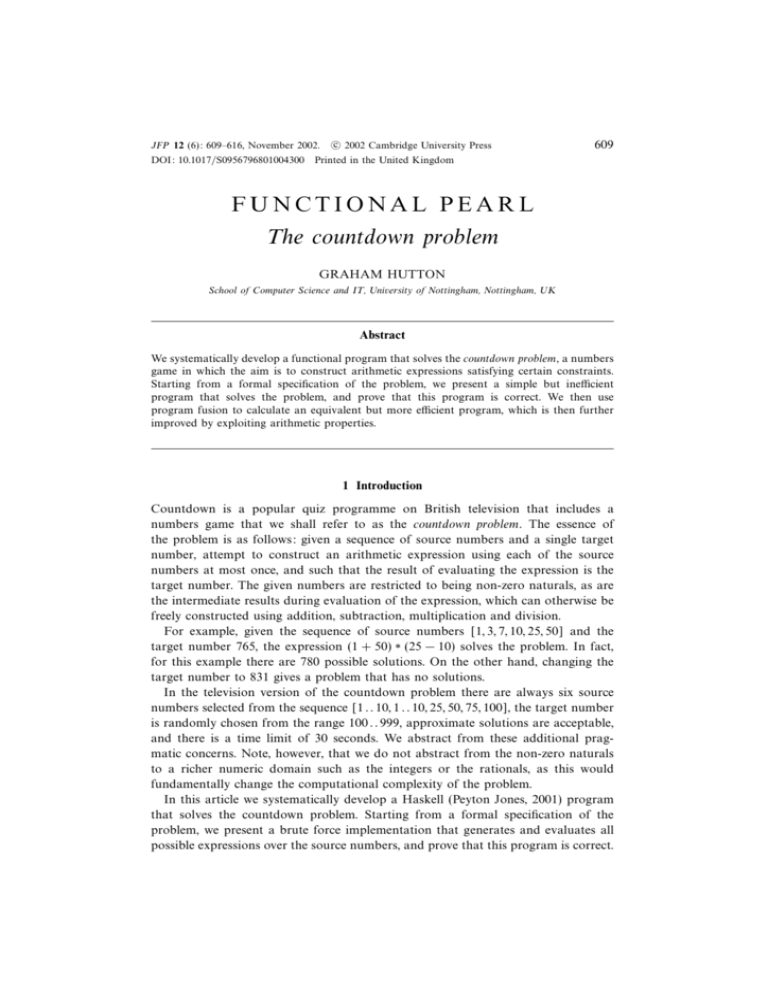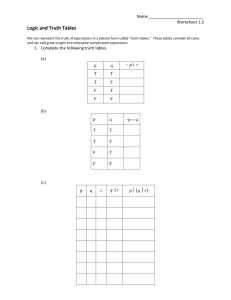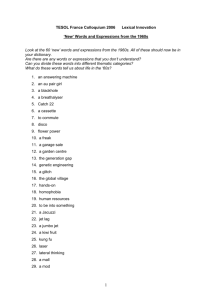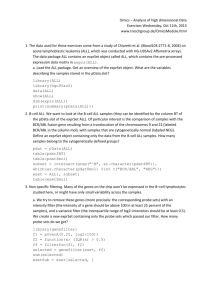The countdown problem - School of Computer Science
advertisement

c 2002 Cambridge University Press
JFP 12 (6): 609–616, November 2002. !
DOI: 10.1017/S0956796801004300
609
Printed in the United Kingdom
FUNCTIONAL PEARL
The countdown problem
GRAHAM HUTTON
School of Computer Science and IT, University of Nottingham, Nottingham, UK
Abstract
We systematically develop a functional program that solves the countdown problem, a numbers
game in which the aim is to construct arithmetic expressions satisfying certain constraints.
Starting from a formal specification of the problem, we present a simple but inefficient
program that solves the problem, and prove that this program is correct. We then use
program fusion to calculate an equivalent but more efficient program, which is then further
improved by exploiting arithmetic properties.
1 Introduction
Countdown is a popular quiz programme on British television that includes a
numbers game that we shall refer to as the countdown problem. The essence of
the problem is as follows: given a sequence of source numbers and a single target
number, attempt to construct an arithmetic expression using each of the source
numbers at most once, and such that the result of evaluating the expression is the
target number. The given numbers are restricted to being non-zero naturals, as are
the intermediate results during evaluation of the expression, which can otherwise be
freely constructed using addition, subtraction, multiplication and division.
For example, given the sequence of source numbers [1, 3, 7, 10, 25, 50] and the
target number 765, the expression (1 + 50) ∗ (25 − 10) solves the problem. In fact,
for this example there are 780 possible solutions. On the other hand, changing the
target number to 831 gives a problem that has no solutions.
In the television version of the countdown problem there are always six source
numbers selected from the sequence [1 . . 10, 1 . . 10, 25, 50, 75, 100], the target number
is randomly chosen from the range 100 . . 999, approximate solutions are acceptable,
and there is a time limit of 30 seconds. We abstract from these additional pragmatic concerns. Note, however, that we do not abstract from the non-zero naturals
to a richer numeric domain such as the integers or the rationals, as this would
fundamentally change the computational complexity of the problem.
In this article we systematically develop a Haskell (Peyton Jones, 2001) program
that solves the countdown problem. Starting from a formal specification of the
problem, we present a brute force implementation that generates and evaluates all
possible expressions over the source numbers, and prove that this program is correct.
610
G. Hutton
We then calculate an equivalent but more efficient program by fusing together the
generation and evaluation phases, and finally make a further improvement by
exploiting arithmetic properties to reduce the search and solution spaces.
2 Formally specifying the problem
We start by defining a type Op of arithmetic operators, together with a predicate
valid that decides if applying an operator to two non-zero naturals gives a non-zero
natural, and a function apply that actually performs the application:
Add | Sub | Mul | Div
data Op
=
valid
valid
valid
valid
valid
Add
Sub x y
Mul
Div x y
::
=
=
=
=
apply
apply
apply
apply
apply
Add x y
Sub x y
Mul x y
Div x y
:: Op → Int → Int → Int
= x +y
= x −y
= x ∗y
= x ‘div ‘ y
Op → Int → Int → Bool
True
x >y
True
x ‘mod ‘ y == 0
We now define a type Expr of arithmetic expressions, together with a function values
that returns the list of values in an expression, and a function eval that returns the
overall value of an expression, provided that it is a non-zero natural:
Val Int | App Op Expr Expr
data Expr
=
values
values (Val n)
values (App l r)
:: Expr → [Int ]
= [n ]
= values l +
+ values r
eval
eval (Val n)
eval (App o l r)
:: Expr → [Int ]
= [n | n > 0]
= [apply o x y | x ← eval l , y ← eval r, valid o x y ]
Note that failure within eval is handled by returning a list of results, with the
convention that a singleton list denotes success, and the empty list denotes failure.
Such failure could also be handled using the Maybe monad and the do notation
(Spivey, 1990; Launchbury, 1993), but limiting the use of monads in our programs
to the list monad and the comprehension notation leads to simpler proofs.
Using the combinatorial functions subs and perms that return the lists of all
subsequences and permutations of a list (Bird & Wadler, 1988), we define a function
subbags that returns the list of all permutations of all subsequences of a list:
subbags
subbags xs
::
=
[a ] → [[a ]]
[zs | ys ← subs xs, zs ← perms ys ]
Functional pearl
611
Finally, we can now define a predicate solution that formally specifies what it
means to solve an instance of the countdown problem:
solution
solution e ns n
::
=
Expr → [Int ] → Int → Bool
elem (values e) (subbags ns) ∧ eval e == [n ]
That is, an expression e is a solution for a list of source numbers ns and a target
number n if the list of values in the expression is a subbag of the source numbers
(the library function elem decides if a value is an element of a list) and the expression
successfully evaluates to give the target number.
3 Brute force implementation
In this section we present a program that solves countdown problems by the brute
force approach of generating and evaluating all possible expressions over the source
numbers. We start by defining a function split that takes a list and returns the list
of all pairs of lists that append to give the original list:
split
split [ ]
split (x : xs)
:: [a ] → [([a ], [a ])]
= [([ ], [ ])]
= ([ ], x : xs) : [(x : ls, rs) | (ls, rs) ← split xs ]
For example, split [1, 2] returns the list [([ ], [1, 2]), ([1], [2]), ([1, 2], [ ])]. In turn, we
define a function nesplit that only returns those splittings of a list for which neither
component is empty (the library function filter selects the elements of a list that
satisfy a predicate, while null decides if a list is empty or not):
nesplit
nesplit
::
=
ne
::
ne (xs, ys) =
[a ] → [([a ], [a ])]
filter ne ◦ split
([a ], [b ]) → Bool
¬ (null xs ∨ null ys)
Other definitions for split and nesplit are possible (for example, using the library
functions zip, inits and tails), but the above definitions lead to simpler proofs. Using
nesplit we can now define the key function exprs, which returns the list of all
expressions whose values are precisely a given list of numbers:
exprs
exprs [ ]
exprs [n ]
exprs ns
:: [Int ] → [Expr ]
= []
= [Val n ]
= [e | (ls, rs) ← nesplit ns, l ← exprs ls,
r ← exprs rs, e ← combine l r ]
That is, for the empty list of numbers there are no expressions, while for a single
number there is a single expression comprising that number. Otherwise, we calculate
all non-empty splittings of the list, recursively calculate the expressions for each
of these lists, and then combine each pair of expressions using each of the four
612
G. Hutton
arithmetic operators by means of an auxiliary function defined as follows:
combine
combine l r
ops
ops
:: Expr → Expr → [Expr ]
= [App o l r | o ← ops ]
:: [Op ]
= [Add , Sub, Mul , Div ]
Finally, we can now define a function solutions that returns the list of all expressions that solve an instance of the countdown problem by generating all possible
expressions over each subbag of the source numbers, and then selecting those
expressions that successfully evaluate to give the target number:
solutions
solutions ns n
::
=
[Int ] → Int → [Expr ]
[e | ns ) ← subbags ns, e ← exprs ns ) , eval e == [n ]]
For example, using the Glasgow Haskell Compiler (version 5.00.2) on a 1GHz
Pentium-III laptop, solutions [1, 3, 7, 10, 25, 50] 765 returns the first solution in 0.89
seconds and all 780 solutions in 113.74 seconds, while if the target number is changed
to 831 then the empty list of solutions is returned in 104.10 seconds.
4 Proof of correctness
In this section we prove that our brute force implementation is correct with respect
to our formal specification of the problem. For the purposes of our proofs, all lists
are assumed to be finite. We start by showing the sense in which the auxiliary
function split is an inverse to the append operator (+
+):
Lemma 1 elem (xs, ys) (split zs) ⇔ xs +
+ ys == zs
Proof By induction on zs.
!
Our second result states that a value is an element of a filtered list precisely when
it is an element of the original list and satisfies the predicate:
Lemma 2 If p is total (never returns ⊥) then
elem x ( filter p xs) ⇔ elem x xs ∧ p x
Proof By induction on xs.
!
Using the two results above, we can now show by simple equational reasoning
that the function nesplit is an inverse to (++) for non-empty lists:
Lemma 3 elem (xs, ys) (nesplit zs) ⇔ xs +
+ ys == zs ∧ ne (xs, ys)
Proof
elem (xs, ys) (nesplit zs)
{ definition of nesplit }
elem (xs, ys) ( filter ne (split zs))
⇔
{ Lemma 2, ne is total }
elem (xs, ys) (split zs) ∧ ne (xs, ys)
⇔
{ Lemma 1 }
xs +
+ ys == zs ∧ ne (xs, ys) !
⇔
Functional pearl
613
In turn, this result can be used to show that the function nesplit returns pairs of
lists whose lengths are strictly shorter than the original list:
Lemma 4 if elem (xs, ys) (nesplit zs) then
length xs < length zs ∧ length ys < length zs
Proof By equational reasoning, using Lemma 3.
!
Using the previous two results we can now establish the key lemma, which states
that the function exprs is an inverse to the function values:
Lemma 5 elem e (exprs ns) ⇔ values e == ns
Proof By induction on the length of ns, using Lemmas 3 and 4.
!
Finally, it is now straightforward to state and prove that our brute force implementation is correct, in the sense that the function solutions returns the list of all
expressions that satisfy the predicate solution:
Theorem 6 elem e (solutions ns n) ⇔ solution e ns n
Proof
⇔
⇔
⇔
⇔
⇔
⇔
elem e (solutions ns n)
{ definition of solutions }
elem e [e ) | ns ) ← subbags ns, e ) ← exprs ns ) , eval e ) == [n ]]
{ list comprehensions, Lemma 2 }
elem e [e ) | ns ) ← subbags ns, e ) ← exprs ns ] ∧ eval e == [n ]
{ simplification }
or [elem e (exprs ns ) ) | ns ) ← subbags ns ] ∧ eval e == [n ]
{ Lemma 5 }
or [values e == ns ) | ns ) ← subbags ns ] ∧ eval e == [n ]
{ definition of elem }
elem (values e) (subbags ns) ∧ eval e == [n ]
{ definition of solution }
solution e ns n !
5 Fusing generation and evaluation
The function solutions generates all possible expressions over the source numbers,
but many of these expressions will typically be invalid (fail to evaluate), because
non-zero naturals are not closed under subtraction and division. For example, there
are 33,665,406 possible expressions over the source numbers [1, 3, 7, 10, 25, 50], but
only 4,672,540 of these expressions are valid, which is just under 14%.
In this section we calculate an equivalent but more efficient program by fusing
together the generation and evaluation phases to give a new function results that
performs both tasks simultaneously, thus allowing invalid expressions to be rejected
at an earlier stage. We start by defining a type Result of valid expressions paired
614
G. Hutton
with their values, together with a specification for results:
type Result
=
(Expr, Int)
results
results ns
::
=
[Int ] → [Result ]
[(e, n) | e ← exprs ns, n ← eval e ]
Using this specification, we can now calculate an implementation for results by
induction on the length of ns. For the base cases length ns = 0 and length ns = 1,
simple calculations show that results [ ] = [ ] and results [n ] = [(Val n, n) | n > 0].
For the inductive case length ns > 1, we calculate as follows:
=
=
=
=
=
=
=
results ns
{ definition of results }
[(e, n) | e ← exprs ns, n ← eval e ]
{ definition of exprs, simplification }
[(e, n) | (ls, rs) ← nesplit ns, l ← exprs ls,
r ← exprs rs, e ← combine l r, n ← eval e ]
{ definition of combine, simplification }
[(App o l r, n) | (ls, rs) ← nesplit ns, l ← exprs ls,
r ← exprs rs, o ← ops, n ← eval (App o l r)]
{ definition of eval , simplification }
[(App o l r, apply o x y) | (ls, rs) ← nesplit ns, l ← exprs ls,
r ← exprs rs, o ← ops, x ← eval l , y ← eval r, valid o x y ]
{ moving the x and y generators }
[(App o l r, apply o x y) | (ls, rs) ← nesplit ns, l ← exprs ls,
x ← eval l , r ← exprs rs, y ← eval r, o ← ops, valid o x y ]
{ induction hypothesis, Lemma 4 }
[(App o l r, apply o x y) | (ls, rs) ← nesplit ns, (l , x ) ← results ls,
(r, y) ← results rs, o ← ops, valid o x y ]
{ simplification (see below) }
[res | (ls, rs) ← nesplit ns, lx ← results ls,
ry ← results rs, res ← combine ) lx ry ]
The final step above introduces an auxiliary function combine ) that combines two
results using each of the four arithmetic operators:
combine )
combine ) (l , x ) (r, y)
::
=
Result → Result → [Result ]
[(App o l r, apply o x y) | o ← ops, valid o x y ]
In summary, we have calculated the following implementation for results:
results
results [ ]
results [n ]
results ns
:: [Int ] → [Result ]
= []
= [(Val n, n) | n > 0]
= [res | (ls, rs) ← nesplit ns, lx ← results ls,
ry ← results rs, res ← combine ) lx ry ]
Using results, we can now define a new function solutions ) that returns the list of
all expressions that solve an instance of the countdown problem by generating all
Functional pearl
615
possible results over each subbag of the source numbers, and then selecting those
expressions whose value is the target number:
solutions )
solutions ) ns n
::
=
[Int ] → Int → [Expr ]
[e | ns ) ← subbags ns, (e, m) ← results ns ) , m == n ]
It is now straightforward to show that our fused implementation is correct, in the
sense that it has the same behaviour as our brute force version:
Theorem 7 solutions ) = solutions
Proof
=
=
=
=
solutions ) ns n
{ definition of solutions ) }
[e | ns ) ← subbags ns, (e, m) ← results ns ) , m == n ]
{ specification of results, simplification }
[e | ns ) ← subbags ns, e ← exprs ns, m ← eval e, m == n ]
{ simplification }
[e | ns ) ← subbags ns, e ← exprs ns, eval e == [n ]]
{ definition of solutions }
solutions ns n !
In terms of performance, solutions ) [1, 3, 7, 10, 25, 50] 765 returns the first solution
in 0.08 seconds (just over 10 times faster than solutions) and all solutions in 5.76
seconds (almost 20 times faster), while if the target is changed to 831 the empty list
is returned in 5.40 seconds (almost 20 times faster).
6 Exploiting arithmetic properties
The language of arithmetic expressions is not a free algebra, but is subject to
equational laws. For example, the equation x + y = y + x states that addition is
commutative, while x / 1 = x states that 1 is the right identity for division. In this
section we make a further improvement to our countdown program by exploiting
such arithmetic properties to reduce the search and solution spaces.
Recall the predicate valid that decides if applying an operator to two non-zero
naturals gives another non-zero natural. This predicate can be strengthened to take
account of the commutativity of addition and multiplication by requiring that their
arguments are in numerical order, and the identity properties of multiplication and
division by requiring that the appropriate arguments are non-unitary:
valid )
valid )
valid )
valid )
valid )
Add x y
Sub x y
Mul x y
Div x y
::
=
=
=
=
Op → Int → Int → Bool
x !y
x >y
x ,= 1 ∧ y ,= 1 ∧ x ! y
y ,= 1 ∧ x ‘mod ‘ y == 0
Using this new predicate gives a new version of our formal specification of the
countdown problem. Although we do not have space to present the full details
616
G. Hutton
here, this new specification is sound with respect to our original specification, in
the sense that any expression that is a solution under the new version is also a
solution under the original. Conversely, the new specification is also complete up to
equivalence of expressions under the exploited arithmetic properties, in the sense that
any expression that is a solution under the original specification can be rewritten to
give an equivalent solution under the new version.
Using valid ) also gives a new version of our fused implementation, which we write
as solutions )) . This new implementation requires no separate proof of correctness
with respect to our new specification, because none of the proofs in previous sections
depend upon the definition of valid , and hence our previous correctness results still
hold under changes to this predicate. However, using solutions )) can considerably
reduce the search and solution spaces. For example, solutions )) [1, 3, 7, 10, 25, 50] 765
only generates 245,644 valid expressions, of which 49 are solutions, which is just
over 5% and 6% respectively of the numbers using solutions ) .
As regards performance, solutions )) [1, 3, 7, 10, 25, 50] 765 now returns the first
solution in 0.04 seconds (twice as fast as solutions ) ) and all solutions in 0.86 seconds
(almost seven times faster), while for the target number 831 the empty list is returned
in 0.80 seconds (almost seven times faster). More generally, given any source and
target numbers from the television version of the countdown problem, our final
program solutions )) typically returns all solutions in under one second, and we have
yet to find such a problem for which it requires more than three seconds.
7 Further work
Possible directions for further work include the use of tabulation or memoisation
to avoid repeated computations, exploiting additional arithmetic properties such
as associativity to further reduce the search and solution spaces, and generating
expressions from the bottom-up rather than from the top-down.
Acknowledgements
Thanks to Richard Bird, Colin Runciman and Mike Spivey for useful comments,
and to Ralf Hinze for the lhs2TeX system for typesetting Haskell code.
References
Bird, R. and Wadler, P. (1988) An Introduction to Functional Programming. Prentice Hall.
Launchbury, J. (1993) Lazy imperative programming. Proceedings of the ACM SIGPLAN
Workshop on State in Programming Languages.
Peyton Jones, S. (2001) Haskell 98: A Non-strict, Purely Functional Language. Available from
www.haskell.org.
Spivey, M. (1990) A functional theory of exceptions. Science of Computer Programming, 14(1),
25–43.









